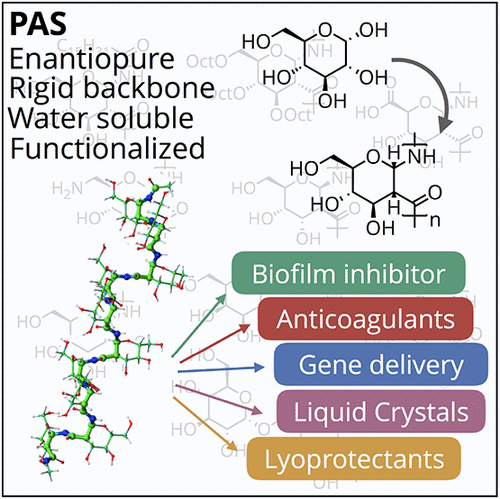当前位置:
X-MOL 学术
›
Acc. Chem. Res.
›
论文详情
Our official English website, www.x-mol.net, welcomes your feedback! (Note: you will need to create a separate account there.)
Poly-Amido-Saccharides (PASs): Functional Synthetic Carbohydrate Polymers Inspired by Nature.
Accounts of Chemical Research ( IF 18.3 ) Pub Date : 2020-09-06 , DOI: 10.1021/acs.accounts.0c00263 Anant S Balijepalli 1 , Mark W Grinstaff 1, 2, 3
Accounts of Chemical Research ( IF 18.3 ) Pub Date : 2020-09-06 , DOI: 10.1021/acs.accounts.0c00263 Anant S Balijepalli 1 , Mark W Grinstaff 1, 2, 3
Affiliation

|
Carbohydrates are ubiquitous in nature, playing vital roles in all organisms ranging from metabolism to intercellular signaling. Polysaccharides, repeating units of small molecule carbohydrates, are hydrophilic, densely functionalized, stereoregular, and rigid macromolecules, and these characteristics are simultaneously advantageous in biomedical applications while presenting major hurdles for synthetic methodology and development of structure property relationships. While naturally obtained polysaccharides are widely utilized in the biochemical and medical literature, their poor physicochemical definition and the potential for contaminated samples hinders the clinical translation of this work. To address the need for new methods to synthesize carbohydrate polymers, we reported a novel class of biomaterials (Poly-Amido-Saccharides; PAS) in 2012. PASs share many properties with natural polysaccharides, such as hydrophilicity, dense hydroxyl functionality, stereoregularity, and a rigid backbone. PASs are connected by an α-1,2-amide linkage, instead of an ether linkage, that confers resistance to enzymatic and hydrolytic degradation and leads to a unique helical conformation. Importantly, our synthetic methodology affords control over molecular weight distribution resulting in pure, well-defined polymers. This Account provides an overview of the development of PAS, from the factors that initially motivated our research to current efforts to translate functional PAS to biomedical applications. We detail the synthesis of glucose- and galactose-based PAS and their biophysical properties including conformation analysis, lectin interactions, cell internalization, and water solubility. Additionally, we describe postpolymerization modification strategies to afford PASs that act as protein stabilizers. We also highlight our recent efforts toward a mechanistic understanding of monomer synthesis via [2 + 2] cycloaddition reactions in order to develop novel monomers with different stereochemistry and amine or alkyl functionality, thereby accessing functional carbohydrate polymers. Throughout our work, we apply computational and theoretical analysis to explain how properties at the monomer level (e.g., stereochemistry, functionality) significantly impact polymer properties, helical conformation, and bioactivities. Collectively, the results from the theoretical, synthetic, and applied aspects of this research advance us toward our goal of utilizing PASs in key biomedical applications as alternatives to natural polysaccharides. The importance of carbohydrates in nature and the versatility of their functions continue to inspire our investigation of new monomers, polymers, and copolymers, leveraging the advantageous properties of PAS to develop potential therapies.
中文翻译:

聚酰胺糖(PASs):受自然启发的功能性合成碳水化合物聚合物。
碳水化合物在自然界无处不在,在从代谢到细胞间信号传导的所有生物中都起着至关重要的作用。多糖是小分子碳水化合物的重复单元,是亲水的,稠密的功能化,有规立构的和刚性的大分子,这些特性在生物医学应用中同时具有优势,同时为合成方法和结构特性关系的发展提出了主要障碍。尽管天然获得的多糖在生化和医学文献中得到了广泛利用,但其较差的理化定义和受污染样品的可能性阻碍了这项工作的临床翻译。为了满足合成碳水化合物聚合物的新方法的需求,我们在2012年报告了一类新型的生物材料(聚氨基酰胺糖; PAS)。PAS与天然多糖具有许多特性,例如亲水性,致密的羟基官能度,立构规整性和刚性骨架。PAS通过α-1,2-酰胺键而不是醚键连接,从而赋予了对酶和水解降解的抵抗力,并导致了独特的螺旋构象。重要的是,我们的合成方法可控制分子量分布,从而得到纯净,轮廓分明的聚合物。该帐户概述了PAS的发展,从最初激发我们研究的因素到当前将功能性PAS转换为生物医学应用的工作。我们详细介绍了基于葡萄糖和半乳糖的PAS的合成及其生物物理特性,包括构象分析,凝集素相互作用,细胞内在化和水溶性。此外,我们描述了聚合后修饰策略,以提供充当蛋白质稳定剂的PAS。我们还强调了我们最近对通过[2 + 2]环加成反应对单体合成进行机械理解的努力,以便开发具有不同立体化学和胺或烷基官能度的新型单体,从而获得功能性碳水化合物聚合物。在我们的整个工作中,我们应用计算和理论分析来解释单体水平的性质(例如,立体化学,官能度)如何显着影响聚合物的性质,螺旋构象和生物活性。总而言之,这项研究的理论,合成和应用方面的结果使我们朝着在关键生物医学应用中利用PAS替代天然多糖的目标迈进。
更新日期:2020-10-21
中文翻译:

聚酰胺糖(PASs):受自然启发的功能性合成碳水化合物聚合物。
碳水化合物在自然界无处不在,在从代谢到细胞间信号传导的所有生物中都起着至关重要的作用。多糖是小分子碳水化合物的重复单元,是亲水的,稠密的功能化,有规立构的和刚性的大分子,这些特性在生物医学应用中同时具有优势,同时为合成方法和结构特性关系的发展提出了主要障碍。尽管天然获得的多糖在生化和医学文献中得到了广泛利用,但其较差的理化定义和受污染样品的可能性阻碍了这项工作的临床翻译。为了满足合成碳水化合物聚合物的新方法的需求,我们在2012年报告了一类新型的生物材料(聚氨基酰胺糖; PAS)。PAS与天然多糖具有许多特性,例如亲水性,致密的羟基官能度,立构规整性和刚性骨架。PAS通过α-1,2-酰胺键而不是醚键连接,从而赋予了对酶和水解降解的抵抗力,并导致了独特的螺旋构象。重要的是,我们的合成方法可控制分子量分布,从而得到纯净,轮廓分明的聚合物。该帐户概述了PAS的发展,从最初激发我们研究的因素到当前将功能性PAS转换为生物医学应用的工作。我们详细介绍了基于葡萄糖和半乳糖的PAS的合成及其生物物理特性,包括构象分析,凝集素相互作用,细胞内在化和水溶性。此外,我们描述了聚合后修饰策略,以提供充当蛋白质稳定剂的PAS。我们还强调了我们最近对通过[2 + 2]环加成反应对单体合成进行机械理解的努力,以便开发具有不同立体化学和胺或烷基官能度的新型单体,从而获得功能性碳水化合物聚合物。在我们的整个工作中,我们应用计算和理论分析来解释单体水平的性质(例如,立体化学,官能度)如何显着影响聚合物的性质,螺旋构象和生物活性。总而言之,这项研究的理论,合成和应用方面的结果使我们朝着在关键生物医学应用中利用PAS替代天然多糖的目标迈进。



























 京公网安备 11010802027423号
京公网安备 11010802027423号